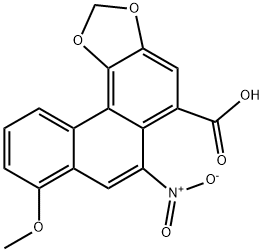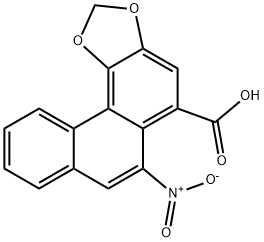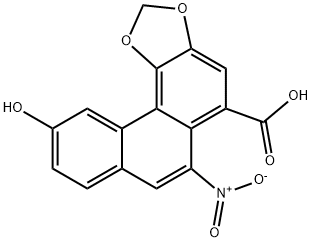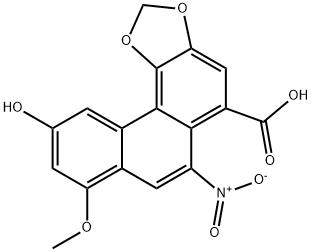Aristolochic acid
Synonym(s):TR 1736
- CAS NO.:313-67-7
- Empirical Formula: C17H11NO7
- Molecular Weight: 341.27
- MDL number: MFCD00004996
- EINECS: 206-238-3
- SAFETY DATA SHEET (SDS)
- Update Date: 2025-12-27 15:38:00

What is Aristolochic acid?
Description
According to the Merck Index, aristolochic acids are “a group of 14 . . . substituted 1-phenanthrenecarboxylic acids . . . that occur in [the flowering plant family] Aristolochiaceae and in butterflies feeding on these plants.” Aristolochic acid I, shown here, is the most abundant of the group.
In 1953, H. G?nshirt at the Karlsruhe Institute of Technology (Germany) isolated aristolochic acids from several plants in the genus Aristolochia and determined their concentrations. In the following years, other researchers also isolated the acids, including M. Pailer and co-workers at the University of Vienna, who determined the chemical structures of several of the acids.
As shown in the hazard information table, aristolochic acids are highly toxic. They are suspected of causing the severe kidney disease Balkan endemic nephropathy (BEN) that is widespread in the Balkan Peninsula of Europe. A plant called birthwort (Aristolochia clematitis) is abundant in this region. It grows in wheatfields, where its contents enter the soil and groundwater and contaminate the crop. Epidemiologists estimate that ≈100,000 people are affected by BEN in the region.
But this is only a small part of the problem. As many as hundreds of millions or even billions of people may suffer from BEN worldwide. This is because Aristolochiaceae plants (genera Aristolochia and Asarum) have been used in traditional medicines for millennia, especially in Asia. In addition to BEN, individuals who consume these medicines can also develop aristolochic acid–induced liver cancer.
Description
Aristolochic acid first appeared in Chinese medicine in the fifth century AD, while it was used to treat kidney and urinary diseases, as well as gout, snakebites, and a variety of other ailments. In many of these cases, aristolochic acid was just one of the main components of the salves. In the first century, aristolochic acid was first described as a composition of ingested medicine to treat symptoms such as asthma, hiccups, pains, and spasms.
Chemical properties
Shiny brown leaflets or a yellow or white powder.
Physical properties
Appearance: brown sheet crystal or yellow powder. Solubility: practically insoluble in water and soluble in ethanol, chloroform, ethyl ether, acetone, glacial acetic acid, and aniline. Melting point: 260–265?°C (500–509?°F; 533–538?K).
History
At a clinic in Brussels, Belgium, a group of women who had all taken the same weight loss supplement, Aristolochia fangchi, which contained aristolochic acid, was first diagnosed with aristolochic acid poisoning. Balkan endemic nephropathy (BEN) was later found to be also the result of aristolochic acid (AA) consumption. Balkan endemic nephropathy is likely caused by low-level AA exposure, possibly from the contamination of wheat flour seeds by Aristolochia clematitis. BEN falls under the umbrella of what is now known as aristolochic acid nephropathy, the prevalent symptom of AA poisoning .
The Uses of Aristolochic acid
Aristolochic acid I is a potent phospholipase A2 inhibitor. Aristolochic acid I induces tumor formation in rat kidneys and apoptosis in human renal proximal tubular epithelial cells.
The Uses of Aristolochic acid
Aristolochic acids occur in Aristolochiaceae and in butterflies feeding on these plants. One of a group of fourteen known, substituted 1-phenanthrenecarboxylic acids
The Uses of Aristolochic acid
PLA2 inhibitor
What are the applications of Application
Aristolochic Acid is a PLA2 and edema-inducing activity inhibitor
Definition
ChEBI: A monocarboxylic acid that is phenanthrene-1-carboxylic acid that is substituted by a methylenedioxy group at the 3,4 positions, by a methoxy group at position 8, and by a nitro group at position 10. It is the most abundant of the aristolochic acids and is found in almost all Aristolochia (birthworts or pipevines) species. It has been tried in a number of treatments for inflammatory disorders, mainly in Chinese and folk medicine. However, there is concern over their use as aristolochic acid is b th carcinogenic and nephrotoxic.
Indications
Due to the widely associated kidney problems and urothelial cancers, the FDA has issued warnings regarding consumption of AA-containing supplements.
brand name
Acidum aristolchicum;Descresepet;Fago-araxin;Fluocinova;Predno-facilus haemota.
World Health Organization (WHO)
Extracts of aristolochiaceae have traditionally been used as a bitter for which a broad range of therapeutic effects has been claimed. Aristolochic acid is claimed to promote phagocytosis and to have immunostimulant activity. However, in 1981, a three-month toxicity study in rats revealed the carcinogenic potential of aristolochic acid and preparations containing this substance have since been withdrawn in several countries.
General Description
This substance is a primary reference substance with assigned absolute purity (considering chromatographic purity, water, residual solvents, inorganic impurities). The exact value can be found on the certificate. Produced by PhytoLab GmbH & Co. KG
Biochem/physiol Actions
Potent phospholipase A2 inhibitor, including calcium ionophore-induced phospholipase A2 activity in neutrophils. Kidney tumor initiator in experimental animal model.
Pharmacology
In 1992, some cases of women present with a rapidly progressive renal failure after having a slimming regimen including powdered extracts of Chinese herbal preparations. This outbreak of renal failure eventually resulted in about 100 cases in 1998, 70% of them being in end-stage renal disease (ESRD) . Recent research has confirmed that the main reason leading to renal injury is aristolochic acid found in many Chinese herbs . Aristolochic acid, a potent human carcinogen from Aristolochia plants, is associated with the incidence of urothelial carcinoma in the upper urinary tract (UUC). After the metabolic activation, aristolochic acid reacted with DNA to form aristolactam (AL)-DNA adducts. Mainly pathological changes are in renal cortex, where they serve as a specific biomarker, and are also found in urothelium, where they lead to a unique mutational signature in the TP53 tumorsuppressor gene. The conclusion is that exposure to aristolochic acid gives rise to the incidence of UUC, a finding with significant implications for the global public health .
Clinical Use
Aristolochia species are nephrotoxic and carcinogenic, and FDA has issued warnings regarding consumption of AA-containing supplements.
Safety Profile
Confirmed carcinogen. Poison by ingestion, intraperitoneal, and intravenous routes. Mutation data reported. When heated to decomposition it emits toxic fumes of NO,. Potentially Toxic Chemicals: April 1982." Vol. 5 No. 1: The Ministry of Health of the Federal Republic of Germany has withdrawn from the national market drugs containing aristolochic acid. The decision resulted from the demonstration of a carcinogenic potential in a three-month ingestion toxicity study undertaken in rats. Aristolochic acid is claimed to promote phagocytosis and to have immunostimulant activity. A growth-inhibiting effect on experimentally induced tumors has been described, but this effect has not been shown to have any clinical relevance. Extracts of species of Aristolochiacea have tradtionally been used as a bitter, and a broad range of therapeutic effects has been claimed.
Potential Exposure
Aristolochic acids are alkaloids used primarily as a chemical intermediate for pharmaceuticals, lab chemicals, herbal extract, drug.
Shipping
UN1544 Alkaloids, solid, n.o.s. or Alkaloid salts, solid, n.o.s. poisonous, Hazard Class: 6.1; Labels: 6.1- Poisonous materials, Technical Name Required. PG III.
Incompatibilities
Compounds of the carboxyl group react with all bases, both inorganic and organic (i.e., amines) releasing substantial heat, water and a salt that may be harmful. Incompatible with oxidizers (chlorates, nitrates, peroxides, permanganates, perchlorates, chlorine, bromine, fluorine, etc.); contact may cause fires or explosions. Keep away from alkaline materials, strong bases, strong acids, oxoacids, epoxides.
Waste Disposal
It is inappropriate and possibly dangerous to the environment to dispose of expired or waste drugs and pharmaceuticals by flushing them down the toilet or discarding them to the trash. Household quantities of expired or waste pharmaceuticals may be mixed with wet cat litter or coffee grounds, double-bagged in plastic, discard in trash. Larger quantities shall carefully take into consideration applicable DEA, EPA, and FDA regulations. If possible return the pharmaceutical to the manufacturer for proper disposal being careful to properly label and securely package the material. Alternatively, the waste pharmaceutical shall be labeled, securely packaged and transported by a state licensed medical waste contractor to dispose by burial in a licensed hazardous or toxic waste landfill or incinerator. All federal, state, and local environmental regulations must be observed.
Properties of Aristolochic acid
| Melting point: | 260 °C |
| Boiling point: | 476.92°C (rough estimate) |
| Density | 1.3162 (rough estimate) |
| refractive index | 1.4500 (estimate) |
| storage temp. | 2-8°C |
| solubility | DMSO: soluble |
| form | powder |
| appearance | yellow crystals or powder |
| pka | 2.99±0.20(Predicted) |
| color | yellow |
| CAS DataBase Reference | 313-67-7(CAS DataBase Reference) |
| IARC | 1 (Vol. 82, 100A) 2012, 1 (Vol. 82, 100A) 2012 |
Safety information for Aristolochic acid
| Signal word | Danger |
| Pictogram(s) |
 Skull and Crossbones Acute Toxicity GHS06  Health Hazard GHS08 |
| GHS Hazard Statements |
H301:Acute toxicity,oral H340:Germ cell mutagenicity H350:Carcinogenicity |
| Precautionary Statement Codes |
P202:Do not handle until all safety precautions have been read and understood. P264:Wash hands thoroughly after handling. P264:Wash skin thouroughly after handling. P270:Do not eat, drink or smoke when using this product. P280:Wear protective gloves/protective clothing/eye protection/face protection. P301+P310:IF SWALLOWED: Immediately call a POISON CENTER or doctor/physician. P405:Store locked up. |
Computed Descriptors for Aristolochic acid
| InChIKey | LIDQMWRBMLSXLL-UHFFFAOYSA-N |
New Products
4,4-Difluoropiperidine hydrochloride tert-butyl 9-methoxy-3-azaspiro[5.5]undecane-3-carboxylate Indole Methyl Resin N-Isopropylurea N,N-Dicyclohexylcarbodiimide(DCC) MELDRUMS ACID 5-METHYLISOXAZOLE-4-CARBOXYLIC ACID Magnessium Bis glycinate Zinc ascorbate 1-bromo-2-butyne 2-acetamidophenol 9(10H)-anthracenone Erythrosin B, 4-Piperidinopiperidine 2-((4-morpholinophenylamino) (methylthio) methylene) malononitrile 2,4-dihydroxybenzaldehyde 3-(4-morpholinophenylamino)-5-amino-1H-pyrazole-4-carbonitrile Methyl 2-methylquinoline-6-carboxylate 2,6-dichloro-4-nitropyridine 4-Bromo-2-chlorobenzonitrile 2-(benzylamino)acetic acid hydrochloride 4-(tert-Butoxycarbonylamino)but- 2-ynoic acid 3,4-dihydro-2H-benzo[b][1,4]dioxepine 1-Phenyl-1-cycloprppanecarboxylicacidRelated products of tetrahydrofuran








You may like
-
 Aristolochic acid I CAS 313-67-7View Details
Aristolochic acid I CAS 313-67-7View Details
313-67-7 -
 Aristolochic acid I CAS 313-67-7View Details
Aristolochic acid I CAS 313-67-7View Details
313-67-7 -
 3-(4-amino-1-oxoisoindolin-2-yl)-1-methylpiperidine-2,6-dione 98%View Details
3-(4-amino-1-oxoisoindolin-2-yl)-1-methylpiperidine-2,6-dione 98%View Details -
 614-19-7 98%View Details
614-19-7 98%View Details
614-19-7 -
 20677-73-0 (2,2-diethoxyethyl)methylamine 98%View Details
20677-73-0 (2,2-diethoxyethyl)methylamine 98%View Details
20677-73-0 -
 3-(4-(hydroxyamino)-1-oxoisoindolin-2-yl)piperidine-2,6-dione 98%View Details
3-(4-(hydroxyamino)-1-oxoisoindolin-2-yl)piperidine-2,6-dione 98%View Details -
 57381-49-4 2-bromo-4-chlorobenzonitrile 98%View Details
57381-49-4 2-bromo-4-chlorobenzonitrile 98%View Details
57381-49-4 -
 4,6-dichloropyrimidine-5-carbaldehyde 98%View Details
4,6-dichloropyrimidine-5-carbaldehyde 98%View Details
5305-40-8
